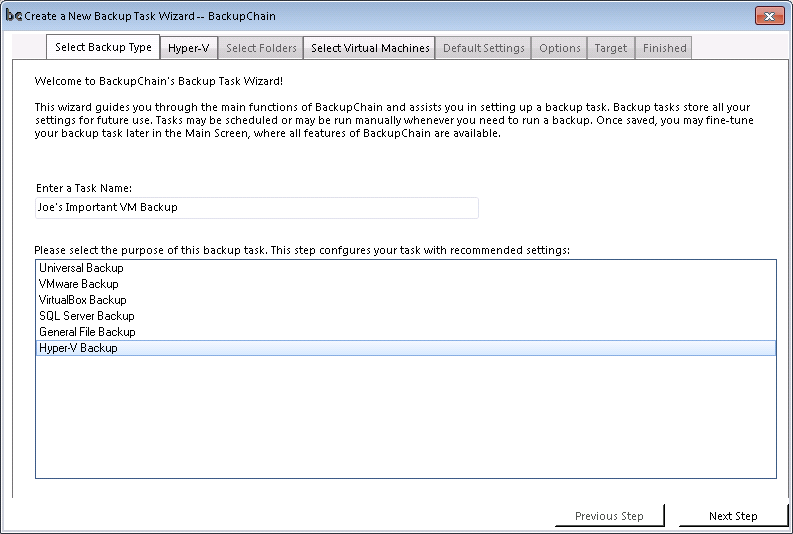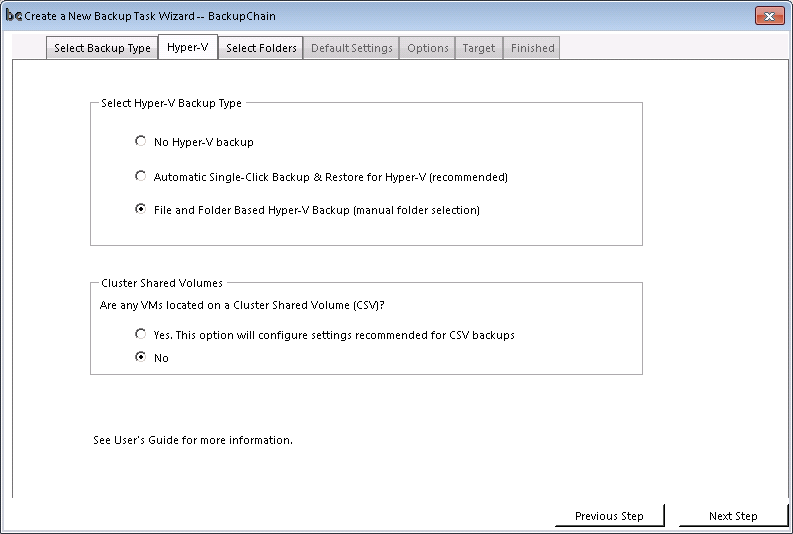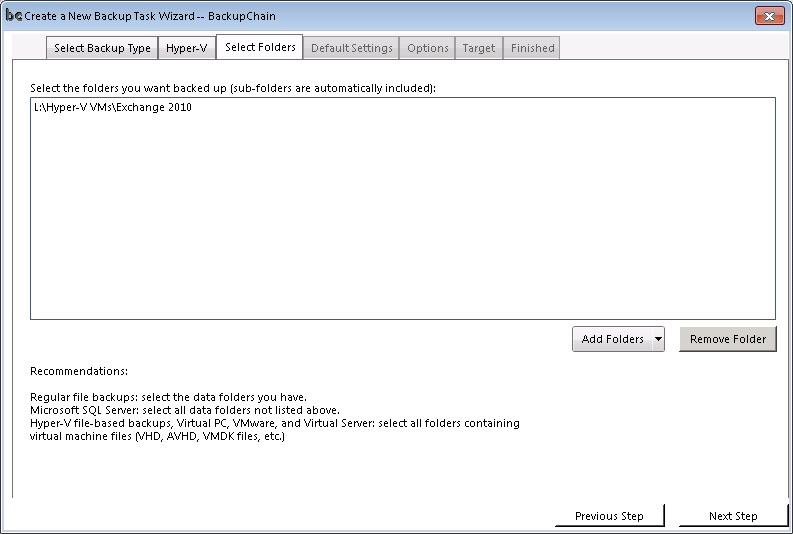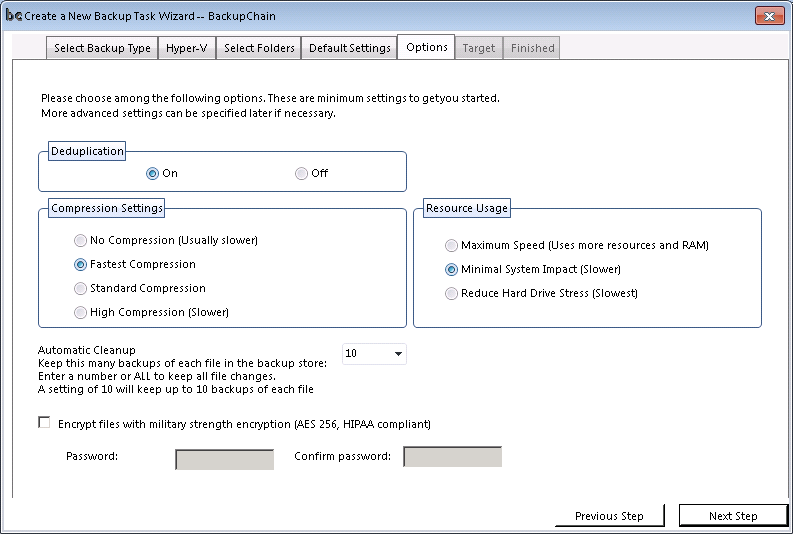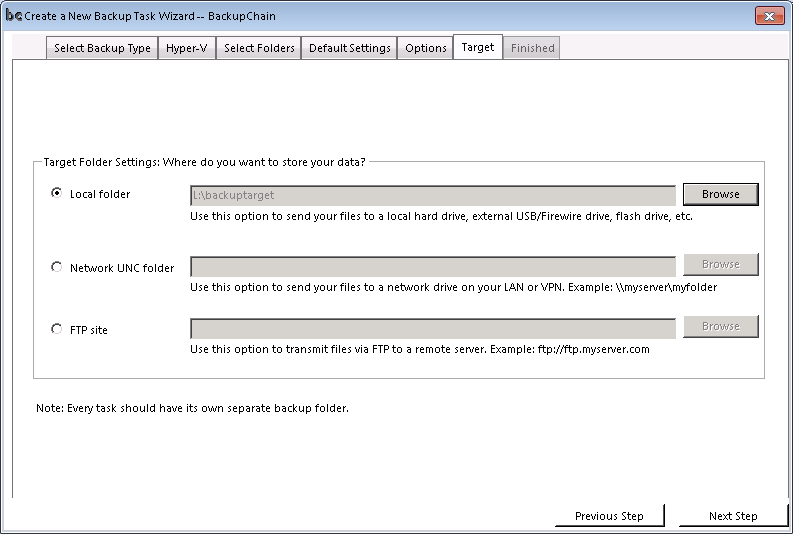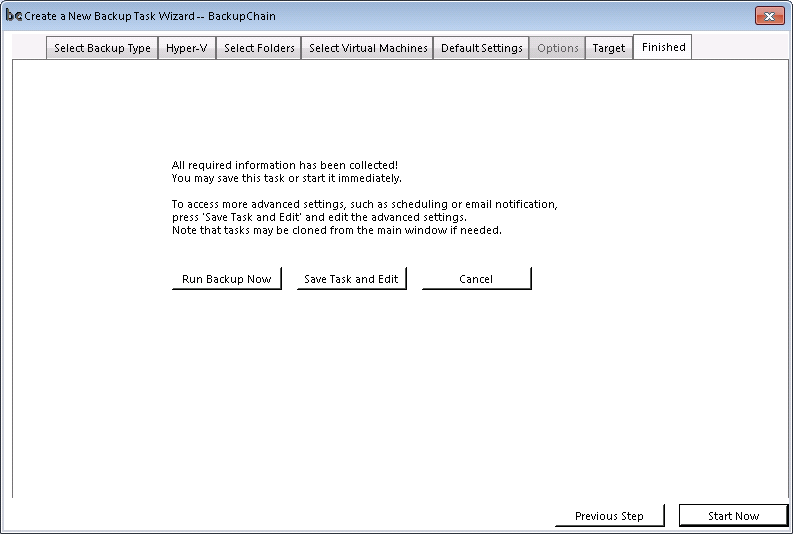How to Create A File-based Backup of Hyper-V
The file-based approach is not recommended unless you are an advanced user. It is not recommended for cluster shared volumes. Most users should use the Automatic Hyper-V Backup feature instead, see next section below.
Note that you can only back up live virtual machines when they are stored locally. Live backup does not work over the network (only exception SAN and CSV backups); this means you cannot pull VMs stored on another server. VMs must be running locally in order to be backed up live. Offline backups (when VMs are shut down) do work over the network, however.
Open the New Backup Wizard and create a new Universal Backup or Hyper-V Backup task using the New Task button. However, it’s recommended to use a Hyper-V backup task type.
Now determine the type of Hyper-V backup you want to use. It’s strongly recommended to use “Automatic Single-Click Backup and Restore” instead of the file and folder based method but since this tutorial describes the file-folder method, we’ll continue with the file-folder type:
If your VMs are located on a cluster shared volume, select the CSV option at the bottom.
Select the folder containing the virtual machine files (VHDs, and Virtual Machine and Snapshots folders)
Note: You cannot pull files over the network. VMs must be installed locally or on a CSV in order for live backup to work.
Next, accept default settings or use custom settings:
Recommended backup settings will turn on deduplication, data compression, and a retention period of 10 file versions (i.e. after the 11th backup of a file the oldest backup is deleted).
“No file processing” switches off deduplication and data compression and uses a retention period of 10 file versions.
If you choose custom settings the following screen opens:
Here you can preset the basic settings of your task in just one screen, such as encryption, deduplication and data compression. All the fine-tuning may be done later in the Main Screen of BackupChain.
Now we are ready to proceed and set the backup target:
In our example above, we use a local drive but you could send your backups to a network device or FTP site instead as well. Note that deduplication does work over standard FTP.
Then click Next Step:
If you want to run the task immediately, click Start Now. Otherwise click Save Task and Edit, to return to the Main Screen where you can add a schedule to the task and change numerous other settings.
Backup Software Overview
The Best Backup Software in 2025 Download BackupChain®BackupChain is the all-in-one server backup software for:
Server Backup
Disk Image Backup
Drive Cloning and Disk Copy
VirtualBox Backup
VMware Backup
Image Backup
FTP Backup
Cloud Backup
File Server Backup
Virtual Machine Backup
BackupChain Server Backup Solution
Hyper-V Backup
Popular
- Best Practices for Server Backups
- NAS Backup: Buffalo, Drobo, Synology
- How to use BackupChain for Cloud and Remote
- DriveMaker: Map FTP, SFTP, S3 Sites to a Drive Letter (Freeware)
Resources
- BackupChain
- VM Backup
- V4 Articles
- Knowledge Base
- FAQ
- BackupChain (German)
- German Help Pages
- BackupChain (Greek)
- BackupChain (Spanish)
- BackupChain (French)
- BackupChain (Dutch)
- BackupChain (Italian)
- Backup.education
- Sitemap
- BackupChain is an all-in-one, reliable backup solution for Windows and Hyper-V that is more affordable than Veeam, Acronis, and Altaro.
Other Backup How-To Guides
- Hyper-V Disadvantages: How Hyper-V Costs You
- Path Too Long? Try Delete Long Path File Freeware Tool DeleteLongPath™
- Video Help Pages
- Live Linux Virtual Machine Backup Without Shutdown or Pause
- Best Network Backup Solution for Windows Server 2025 and Windows 11
- P2V Converter & Backup Software for Hyper-V VMware VirtualBox
- How to Install Hyper-V on a Windows Server 2012 Machine
- Carbonite vs. Acronis vs. BackupChain Cloud Backup Plans Review
- Image Backup for Hyper-V, VMware, OS, VirtualBox, System, Physical
- Backup Software with Encryption for Windows 11, Windows Server 2025
- Hyper-V Backup Error: Could not initiate a checkpoint operation: Element not found. (0x80070490).
- All Fixes for: The driver detected a controller error on \Device\Harddisk2\DR2
- How to Set up P2V, P to V for Hyper-V, Step-by-Step Video
- Restoring a Hyper-V Virtual Machine
- Backup Hyper-V on USB External Hard Drive Pros and Cons
- Backup Software and Long File Names: What You Need To Know
- How to Fix VolSnap 36 Error User Imposed Limit – Volume Snapshot
- Hyper-V Cloud Backup
- Hyper-V Pass-through Disks: Advantages, Disadvantages, and Limitations
- BackupChain®: The Time Machine for Windows


